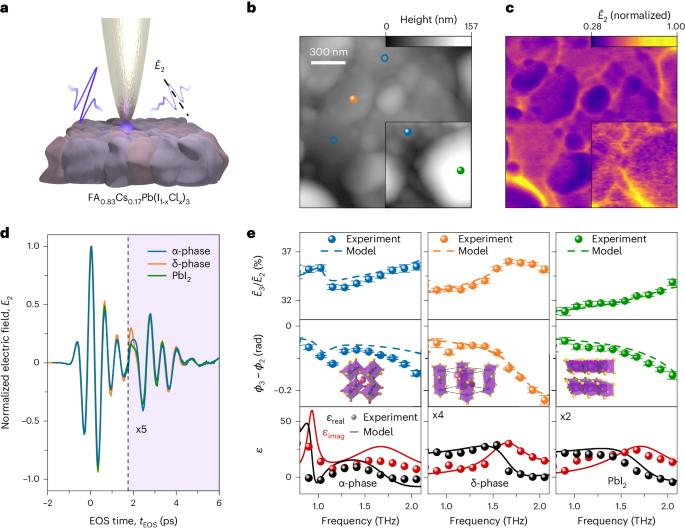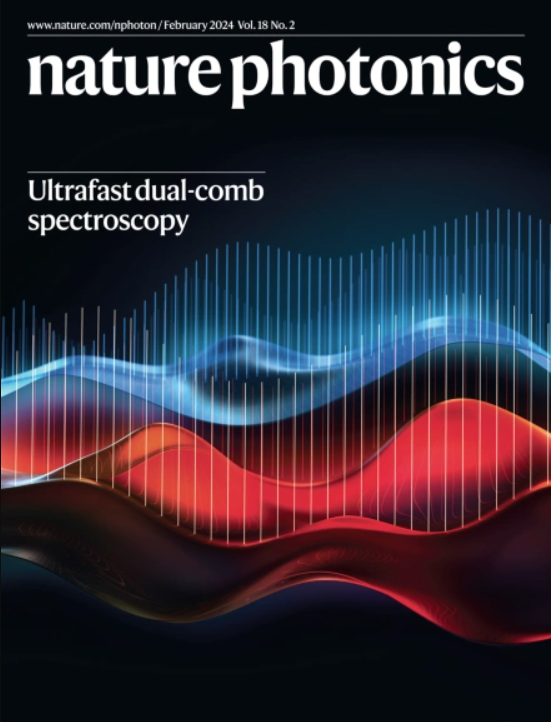In situ nanoscopy of single-grain nanomorphology and ultrafast carrier dynamics in metal halide perovskites
IF 32.3
1区 物理与天体物理
Q1 OPTICS
引用次数: 0
Abstract
Designing next-generation light-harvesting devices requires a detailed understanding of the transport of photoexcited charge carriers. The record-breaking efficiencies of metal halide perovskite solar cells have been linked to effective charge-carrier diffusion, yet the exact nature of charge-carrier out-of-plane transport remains notoriously difficult to explain. The characteristic spatial inhomogeneity of perovskite films with nanograins and crystallographic disorder calls for the simultaneous and hitherto elusive in situ resolution of the chemical composition, the structural phase and the ultrafast dynamics of the local out-of-plane transport. Here we simultaneously probe the intrinsic out-of-plane charge-carrier diffusion and the nanoscale morphology by pushing depth-sensitive terahertz near-field nanospectroscopy to extreme subcycle timescales. In films of the organic–inorganic metal halide perovskite FA0.83Cs0.17Pb(I1−xClx)3 (where FA is formamidinium), domains of the cubic α-phase are clearly distinguished from the trigonal δ-phase and PbI2 nano-islands. By analysing deep-subcycle time shifts of the scattered terahertz waveform after photoexcitation, we access the vertical charge-carrier dynamics within single grains. At all of the measured locations, despite topographic irregularities, diffusion is surprisingly homogeneous on the 100 nm scale, although it varies between mesoscopic regions. Linking in situ carrier transport with nanoscale morphology and chemical composition could introduce a paradigm shift for the analysis and optimization of next-generation optoelectronics that are based on nanocrystalline materials. Transient visible-pump terahertz-probe near-field microscopy enables the simultaneous retrieval of the local chemical composition, crystallographic structure, topography and out-of-plane charge-carrier diffusion in perovskite films.


原位纳米透视金属卤化物过氧化物中的单晶粒纳米形态和超快载流子动力学
设计下一代光收集装置需要详细了解光激发电荷载流子的传输。金属卤化物包晶体太阳能电池破纪录的效率与有效的电荷载流子扩散有关,但电荷载流子平面外传输的确切性质仍然难以解释。具有纳米晶粒和晶体学无序性的透辉石薄膜所特有的空间不均匀性要求同时对化学成分、结构相和局部面外传输的超快动态进行原位解析,而这种解析迄今为止还难以实现。在这里,我们通过将深度敏感的太赫兹近场纳米光谱技术推向极端的亚周期时间尺度,同时探测了固有的面外电荷载流子扩散和纳米级形貌。在有机-无机金属卤化物包晶石 FA0.83Cs0.17Pb(I1-xClx)3(其中 FA 为甲脒基)的薄膜中,立方体 α 相域与三方体 δ 相域和 PbI2 纳米等离子体被清晰地区分开来。通过分析光激发后散射太赫兹波形的深亚周期时移,我们获得了单个晶粒内部的垂直电荷载流子动力学。在所有测量位置,尽管地形不规则,但扩散在 100 纳米尺度上出奇地均匀,尽管在中观区域之间存在差异。将原位载流子传输与纳米级形貌和化学成分联系起来,可以为分析和优化基于纳米晶体材料的下一代光电子学带来范式转变。
本文章由计算机程序翻译,如有差异,请以英文原文为准。
求助全文
约1分钟内获得全文
求助全文
来源期刊

Nature Photonics
物理-光学
CiteScore
54.20
自引率
1.70%
发文量
158
审稿时长
12 months
期刊介绍:
Nature Photonics is a monthly journal dedicated to the scientific study and application of light, known as Photonics. It publishes top-quality, peer-reviewed research across all areas of light generation, manipulation, and detection.
The journal encompasses research into the fundamental properties of light and its interactions with matter, as well as the latest developments in optoelectronic devices and emerging photonics applications. Topics covered include lasers, LEDs, imaging, detectors, optoelectronic devices, quantum optics, biophotonics, optical data storage, spectroscopy, fiber optics, solar energy, displays, terahertz technology, nonlinear optics, plasmonics, nanophotonics, and X-rays.
In addition to research papers and review articles summarizing scientific findings in optoelectronics, Nature Photonics also features News and Views pieces and research highlights. It uniquely includes articles on the business aspects of the industry, such as technology commercialization and market analysis, offering a comprehensive perspective on the field.
 求助内容:
求助内容: 应助结果提醒方式:
应助结果提醒方式:


